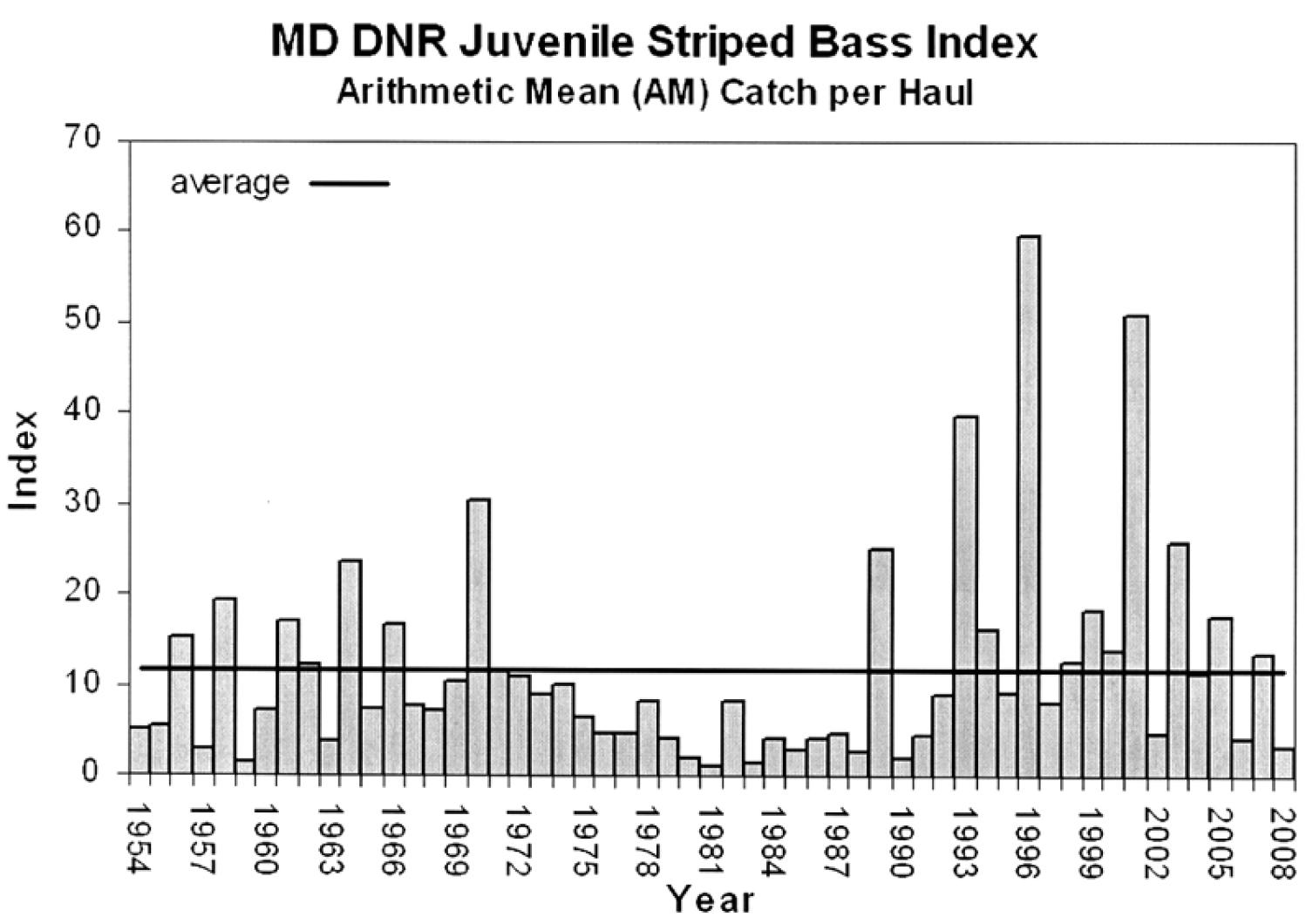Striped bass, the Vineyard’s most valued fish, is struggling.
A new report shows the number of striped bass spawned in the Chesapeake Bay this year was the lowest seen in well over a decade — and fishermen along the Eastern seaboard, alarmed that striped bass may be overfished, are raising concerns about the future of the fishery.
The Maryland Department of Natural Resources last month released the young-of-the-year index, an annual index showing how well striped bass spawned in the Chesapeake Bay. This year’s index is 3.2, well below the long-term average of 11.7, and the lowest number since 1990, when striped bass were just coming out of a near collapse status in the 1980s. Last year the index was 13.39. and it was 4.25 in 2006.
Nearly all of the striped bass which swim in the Atlantic are spawned in the Chesapeake Bay. Stripers are essential to Island waterfront businesses, whether it is a charter fisherman who takes customers out for a day of angling, the commercial angler who fishes and sells his catch in the summer, or the recreational fishermen who plans his vacation around the spring and fall migration.
So it is no surprise that talk on the waterfront is heavy with renewed worry about the health of the stock, weighted down further with the negative news coming out of Maryland.
Maryland fisheries biologists were quick to point out in their initial press release that the index can be highly variable from year to year. It takes a striped bass at least six years to be of harvestable size, 28 inches in length in Massachusetts.
Still, the report prompted recreational fishing advocates to urge greater conservation to insure the fishery doesn’t deteriorate.
Among those seeing trouble is Bradford Burns, president of Stripers Forever, based in Portland. “When you look at the index over the last decade and the decade of the 1990s, you are seeing the smaller years are getting smaller. The fishery management establishment has always put a positive spin on everything. They are doing it at this moment. [But] you look at that graph and the momentum is going in the wrong direction.”
Mr. Burns said his organization, along with others, is advocating that striped bass become a recreational sport fish in Massachusetts. There is no commercial fishing for striped bass in Maine, New Hampshire, Connecticut, New Jersey, Pennsylvania, District of Columbia and South Carolina, nor in federal waters beyond the three-mile state limit. This summer there were very few bass caught in Maine or New Hampshire. It is a game fish on the west coast, Texas, Florida and Georgia. Massachusetts anglers commercially landed 1.158 million pounds this year, 104.5 per cent more than their quota of 1.107 million pounds.
Alexi Sharov, a Maryland Department of Natural Resources fisheries biologist, has been studying the health of striped bass for 11 years. He is a member of the striped bass technical committee within the Atlantic States Marine Fisheries Commission. He and his scientists assess the health of the fishery through indexes like the young of the year, through catch reports coming from up and down the coast and through computer modeling.
Mr. Sharov said there is no need to be concerned. He said scientists have an understanding why there was a decline, and it is not related to the numbers of spawning females. “The working hypothesis is that we had a really strong cold front come into Maryland around the end of May. Water temperatures dropped significantly in the Chesapeake. Larvae don’t like sharp drops in temperature,” he said.
It wasn’t just striped bass that suffered. He said white perch, shad and herring had a poor survival rate this year probably for the same reason.
“Striped bass have a huge survival variability,” Mr. Sharov said. “From year to year there are variations by orders of magnitude and it is because of water temperature, salinity, turbidity and predation. Only a small percentage survive to five or six months old.”
Mike Armstrong, an assistant director with the Massachusetts Division of Marine Fisheries, also said fishermen needn’t be too concerned. “The index is a first shot. It is a pretty good indication of the fish spawned in the year, but it is generally not as bad as it looks,” he said. “Obviously we have our finger on the pulse all the time. Striped bass is the bread and butter of our billion-dollar recreational fishery,” Mr. Armstrong said.
There are meetings throughout the year between fisheries scientists and fisheries managers about the state of fish stocks, he said. Fisheries data gathering is a lot better than it was in the 1980s, when the stocks collapsed and required Congressional action to establish a management regime to bring about restoration. Mr. Armstrong said those oversight measures are still in place to make sure that if striped bass get in trouble, there will be a shift in the management.
“There were a lot of lousy catches in a lot of areas this year. New Hampshire and Maine had nothing. Offshore in Stellwagon Bank striped bass covered the bank. New York, New Jersey and Connecticut had plenty of fish. They caught seven times more than they normally catch. What does that mean? There is a finite pool of fish out there and this year they didn’t come all the way to Massachusetts,” he said.
William (Buddy) Vanderhoop is an Aquinnah charter fishing captain with his own concerns about the striped bass status in these waters. Mr. Vanderhoop said this fall was the worst fishing for striped bass he had ever seen. For 10 days during the month-long Martha’s Vineyard Striped Bass and Bluefish Derby, Mr. Vanderhoop said he couldn’t find any stripers. “That has never happened before. I went to every one of my favorite fishing spots,” he said. In years past, Mr. Vanderhoop said he has had days when he couldn’t catch a fish, but that was only one day. “For 10 days beginning in the first week of October I couldn’t catch fish. I didn’t even catch a short,” Mr. Vanderhoop said.
Mr. Vanderhoop has his own idea about why the stripers weren’t around the Vineyard waters this year. He believes that there is a fleet of large 100-foot fishing boats working federal waters off New England targeting menhaden but they are also harvesting herring and stripers as a bycatch. The large-scale fishing boats are called midwater trawlers and they catch the fish by encircling huge schools of bait fish with football size nets.
“The striped bass follow the herring. There is a video on the Internet showing how devastating the midwater trawls can get. They just discard the bass over the side,” Mr. Vanderhoop said. “Something has to be done about the midwater trawlers and the striped bass migratory season. All the efforts to restore the striped bass will be null and void if they let the trawlers do what they do.”
Cooper A. Gilkes 3rd, runs a tackle shop in Edgartown. He too is concerned about the health of striped bass beyond this year’s Maryland young-of-the-year index. Each spring the Martha’s Vineyard Rod and Gun Club hosts a striped bass catch-and-release tournament. Close to 200 fishermen using mostly barbless hooks go fishing for a night and tabulate the fish they catch and release. “Five years ago the fishermen caught and released 1,200 fish in one night. That could have been exceptional but going back 12 years that is what they did. This year the fishermen caught and released between 200 and 300 fish that night. If the drop wasn’t every single year, I would not be that concerned. But every single year the numbers of fish being caught and released are coming down.”
Mr. Sharov said the striped bass technical committee he attends will meet in January to take up the new information gained this year and look ahead.






Comments (5)
Comments
Comment policy »